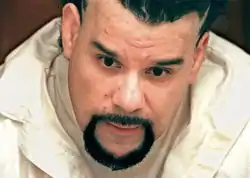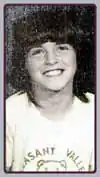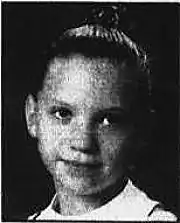Joseph Kondro
Joseph Robert Kondro (1960 – May 3, 2012), known as The Longview Serial Killer, was an American serial killer implicated in the kidnapping, sexual assault and murder of three children in or near Longview, Washington in the 1980s and 1990s: 8-year-old Rima Traxler, 12-year-old Kara Rudd and 8-year-old Chila Silvernails. He confessed to the first two and was strongly suspected in the third, and possibly linked to the disappearances of many other young girls in the region, before his death in prison by natural causes in 2012.
Joseph Kondro | |
|---|---|
 Joseph Kondro | |
| Born | Joseph Robert Kondro 1960 |
| Status | died of natural causes |
| Died | May 3, 2012 (aged 51–52) |
| Other names | The Longview Serial Killer |
| Conviction(s) | Forgery, Sexual assault, Murder, Drug dealing, Theft |
| Criminal penalty | 55 years in prison |
| Details | |
| Victims | 2 convictions, many more strongly suspected |
| Country | US |
| State(s) | Washington |
Date apprehended | 1997 (charged in prison for abduction, rape and murder of Kara Rudd while already jailed on previous charges) |
Early life, psychopathic tendencies and criminal history
Kondro was born to a Chippewa mother with six other children in Michigan, being handed over for adoption at birth and growing up with his adoptive family in Castle Rock, Washington, attending a Catholic parochial school. As he would later admit to police, he showed disturbing psychopathic tendencies from an early age, including engaging in frequent fights with other children, killing animals (including neighborhood pets), wielding a knife and drinking alcoholic beverages since grade school, as early as age 7. Kondro would subsequently elaborate on these early signs of psychopathy by explaining in detail his lack of empathy and violent desires, comparing himself to an alligator lying in wait, coming up occasionally to feed. He also admitted to molesting young girls while still a child himself, developing fantasies about murder as he grew, and began amassing a lengthy criminal record including auto and petty theft, drunk driving, domestic abuse, drug dealing and forgery. Kondro had several children but in significant part due to drug addiction and his recurring troubles with the law, he was not able to care for them.[1][2][3]
Disappearances of Chila Silvernails and Rima Traxler


In the early 1980s, authorities were baffled by the unexplained disappearances of several little girls in southwestern Washington State, including Chila Silvernails of Kalama, Washington, who vanished in 1982 on her way to catching a school bus. Her nude body was found the day after her disappearance; she had been raped and strangled. Kondro had dated Silvernails’ mother, but he was not initially suspected in the crime. Then on May 15, 1985, another 8-year-old girl, Rima Traxler, a third-grader at St. Helens Elementary School in Longview, went missing. She had been a well-behaved and academically successful schoolgirl with little in the way of conflicts or behavioral issues, so the community suspected that she had become a kidnap victim rather than a runaway, but there was little trace of exactly when or how she had disappeared. Kondro had been friends with Rima's mother and stepfather and apparently drinking beer with him on the day she vanished. He was questioned by police, but not named as a person of interest in the case.[1][2][4]
Abduction and murder of Kara Rudd, arrest and prosecution

On November 21, 1996, Kara Rudd, a 12-year-old girl, entered a car after having been dropped off to Monticello Middle School, and vanished. As with the Traxler case, Rudd had been a popular and successful girl with no behavioral issues so she was not suspected as a runaway, and again there was a connection to Joseph Kondro, but this time the suspicions were more concrete. Kondro had been a childhood friend of Kara's mother, was known to the victim herself and had frequently stayed in the family's garage, before being evicted due to his chronic drinking issues. He was seen with lacerations on his skin that he could not explain shortly after Rudd's disappearance, possibly with flecks of nail polish (or nail design or nail art material), suggestive of scratches from a girl's long nails acquired in a struggle. Most strikingly, Rudd had told a classmate of her plan to skip school on the day of her disappearance, and she was seen entering a Pontiac Firebird, a vehicle known to be associated with Kondro, who had been the last person to be seen with her prior to Rudd going missing. Authorities still lacked sufficient evidence to make an arrest, but after a fruitless search over 6 weeks for more clues, a detective on the case, Scott McDaniel, decided to look for additional evidence in the Mount Solo area near the Columbia River, which Kondro was known to frequent. There, police found an abandoned Volkswagen vehicle and Rudd's body inside; she had been raped and strangled. The car had acted as a sort of refrigerator to preserve critical forensic evidence, and DNA samples from the crime scene were found to match samples from Kondro, who was arrested for the abduction, sexual assault and murder of Kara Rudd.[3][1][2][5]
Upon interrogation, Kondro admitted that on the day of Kara Rudd's disappearance, he had lured the girl into his car and taken her to a swimming hole in Germany Creek, and then to an abandoned house near the Columbia River, where he raped and strangled her. Then, to avoid the death penalty, Kondro and his attorneys struck a deal with prosecutors, in which he confessed to the abduction, sexual assault and murder of Rima Traxler more than a decade before. Kondro explained that he was already known and liked by the Traxler family, and he was able to trick the girl into entering his vehicle by mentioning the word "unicorn", which was a safety password taught to her by her parents, and which Kondro had learned from Rima's stepfather. He took her to swim at Germany Creek, where he raped, bludgeoned and strangled Traxler, burying her beside a tree. By the terms of the plea deal, he was sentenced to 55 years in prison at the Washington State Penitentiary in Walla Walla. Because of his violent and psychopathic tendencies and long criminal rap sheet, authorities strongly suspected that Kondro had been involved in the unexplained disappearances of other preteen girls throughout the region, both before the abduction of Rima Traxler in 1985, and between her disappearance and that of Kara Rudd in 1996. Authorities were especially convinced of Kondro's role in the kidnapping, rape and murder of Chila Silvernails in 1982, given the striking similarities in modus operandi between her case and those of the other girls, the location of the crime and the fact that Kondro had dated Silvernails’ mother. Kondro himself admitted to having been a child serial killer preying on many little girls in the area, with additional convictions for molestation and further crimes, and detectives planned to question him further about the other unsolved disappearances, but he balked at discussing the other cases due to concerns about a capital punishment imposition, and died in prison of liver disease likely related to Hepatitis C infection.[1][3][4]
Media and criminal profiling
Joseph Kondro's cases, his victims and the circumstances surrounding his actions have all drawn considerable attention across print, Internet and broadcast media not only due to the heinous nature and horrors of his crimes, but also the possible factors and implications in the development of psychopathy, and the potential for psychological profilers to identify warning signs and traits of serial killers and violent criminals. Such criminal profiles can be used to identify criminals at high risk of becoming violent offenders, expediting both steps to monitor and alter the violent behavior (including in youth detention centers for juvenile offenders) as well as protect potential victims. Kondro exhibited many of the classical traits of psychopathy from a young age, including a short temper and ease to anger, impulsivity, frequent fighting with other kids, physical roughness, wanton killing of animals and early substance abuse, admitting to drinking before the age of 10. However, he later also showed many of the baffling and seeming contradictory qualities of criminals with antisocial personality disorder, and despite some differences in physical appearance, public persona and the M.O. of his crimes, he had many such traits in common with serial killer Ted Bundy. Like Bundy, despite his personal instability and tendency to crime and violence, Kondro was able to come off as quite charming and personable. This allowed him to win the trust of those around him, which he used in the commission of his crimes, often perpetrated against the young daughters of his friends. He was also aware on some level that his actions were immoral and monstrous, even apparently able to empathize with families’ desires for justice, yet he said he could not stop himself and compared his drive to violent crime as an adrenaline rush. He was profiled by John E. Douglas, from the FBI Behavioral Science Unit (BSU) and one of the founders of criminal profiling, on the MSNBC documentary (and subsequently Netflix series) Mindhunter. Douglas also discussed his profiling of Kondro in-depth in his book (co-authored with Mark Olshaker), The Killer Across the Table. The detective work and investigations into the abductions of Rima Traxler and Kara Rudd, and possibilities of Kondro's involvement with other disappearances in the region, were featured in several true crime articles and books, including The Longview Serial Killer by author Lori Carangelo, and a number of television documentaries, including On the Case with Paula Zahn (episode "Broken Trust") and Cold Case Files ("Unicorns and Alligators").[2][3][4][5]
References
- Fischer, Amy M.E. (March 11, 2013). "California author examines life of Joseph Kondro". The Daily News.
- Fischer, Amy M.E. (March 19, 2006). "Most Notorious: Joseph Kondro was a smooth-talking killer". The Daily News.
- Olsen, Lise (August 6, 2001). "'Sociopath' amazed he's not on death row". Seattle Post-Intelligencer.
- Kamb, Lewis (February 21, 2003). "Part 6 – In their own words: The twisted art of murder". Seattle Post-Intelligencer.
- Stasi, Linda (November 29, 2008). "Head detective". New York Post.
External links
- Erika Lyn Smith, Joseph Kondro Child Serial Killer, "Bella Online" (2019).
- Rima Danette Traxler, "The Charley Project" (2018-12-13).
